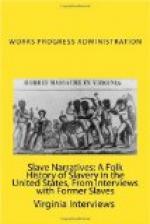Since the slaves had no votes, they had no interest in politics when they became free and knew nothing about political conditions other than that after the Civil War they were free and had a vote. As a boy the Reverend remembers seeing the white and black soldiers marching on election day.
The politicians would always tell the negroes what was good for them and making it appear that it was for their best interest, and they should vote for him, always giving them the desert first and making them think that they were on the level no matter what the meal might be or what hardships they were causing the negro to suffer. On one instance after the negroes were forbidden to vote they marched in a body to the polls and demanded a Democratic ballot and were then permitted to vote.
Rev. Wamble was twenty-seven years of age before he saw and read his first newspaper. He lived with the Wambles for twenty years after the war, when his father then in partnership with another man, purchased forty acres of land. He attended his first school for a period of two months only in 1871. In 1872 the government built a school on his father’s farm and it was taught by a missionary. The school term was for a period of three months each year. The Reverend attended this school for seven years.
In 1880 he married the first time. His first wife died in Memphis, Tennessee, in 1888. By this marriage there were four children. On February 1, 1892, the Reverend with his two surviving children all entered school at a college in Little Rock, Arkansas. One of his daughters died in the third year of her school year, but the other graduated from the Normal School and was a teacher for several years. At the present time she is married to a minister in Louisiana and is the mother of ten children and is a nurse. The three oldest children have degrees and the others are expected to do the same.
The Reverend married his second wife in 1894. She died in 1907. By this marriage nine children were born.
The Reverend has been in the ministry for thirty-seven years. Seeing the need of making more money, two of his sons came to Gary, Indiana, to work in 1924. Now both are working in the post-office. Two years later he came to Gary for the same reason and after working two years in the coke plant, was laid off due to the depression. The youngest daughter of the Reverend by his second marriage graduated from a college in Pine Bluff, Arkansas, and is now teaching in New York City.
Although the Reverend is advanced in years, he is quite active and healthy. He says he has a small pension and is just waiting until it is time to pass on to the next world. He has six children and seventeen grandchildren living.
As the Reverend remembered the south, none of the white people worked at manual labor, but usually sat under a shade tree. They were usually clerks, bookkeepers or tradesmen.
Ex-Slave Stories
5th District
Vanderburgh County
Lauana Creel
1415 S. Barker Avenue, Evansville, Indiana




